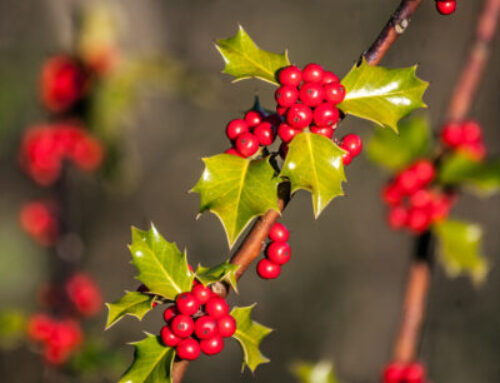Tree enthusiast Steven Teale looks at the seasonal and historical importance of evergreens holly and ivy to both people and wildlife.
Holly Ilex aquifolium and ivy Hedera helix are symbolic plants associated with the winter solstice, yuletide and Christmas traditions. Being evergreen, the plants have been important to people and wildlife at a time when food is scarce throughout history.
Deck the halls
In folklore, holly was allowed to grow tall above the hedges in order to impede witches as they flew above them. For centuries, garlands of holly and ivy have been collected to decorate homes at Christmas, often with ivy outside and holly within (deck the halls), but it was considered unlucky to do so before Christmas Eve, perhaps because cutting the boughs would allow witches to move freely.
Holly was historically a source of livestock fodder at a time when greenery was limited. It’s for this reason that holly was grown for pollarding and stands remain around Staverton Thicks in Suffolk, Stiperstones in Shropshire, the New Forest and Dorset.
Veteran holly
In East Sussex, there is an impressive veteran holly in the churchyard at Barcombe near Lewes and an area of dense holly growth at the rear of the old Union Workhouse at Newhaven, now part of the Meeching Down local nature reserve.
Holly was one of the earliest trees to colonise Britain after the last ice age, when a land bridge still existed to continental Europe. Holly grows in a range of soil types and altitudes and is tolerant of wind, salt, shade, browsing by animals, air pollution and pollarding, but is susceptible to extremes of temperature and moisture.
Holly spines
Holly berries are toxic to humans but birds, such as mistle thrushes Turdus viscivorus, also known as hollin cocks, and robins Erithacus rubecula, will defend individual holly bushes as a food source during cold seasons. Holly leaves above the browseline have fewer spines and it’s possible that holly evolved either to lose its spines above the level reached by deer or to grow spines below a certain level to deter deer from browsing.
Holly’s tough adaptations are so successful at deterring invertebrate larvae that only a few species are associated with it, such as the leaf mining fly Phytomyza ilicis, which causes a distinctive yellow and red blotch mine on its tough leaves.
Caterpillars
The caterpillar of the holly blue butterfly Celastrina argiolus feeds on the developing berries on female holly trees. The butterfly has two broods each year and the second brood is laid on ivy, where the caterpillars feed on the flowers. The caterpillar of the holly tortrix moth Rhopobota neavana also feeds on holly leaves and flowers.
Holly and ivy have been part of our winter traditions for centuries and we continue to decorate our homes with holly wreaths at Christmas to this day. Happy Christmas everyone and may the yuletide log burn bright and warm in your hearths!
Follow Steven Teale’s blog Newhaven Wildlife
Read The holly and the ivy: The seasonal significance of Ilex aquifolium and Hedera helix





